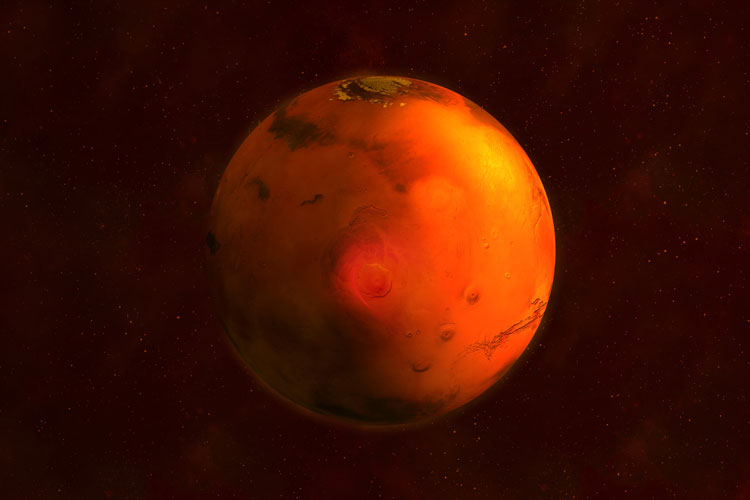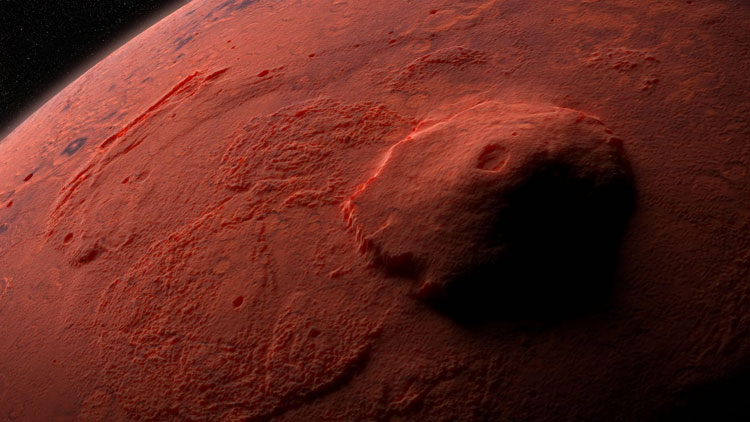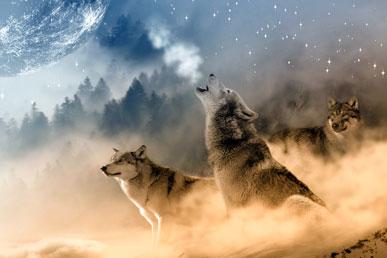
Mars is one of the most studied and mysterious planets in the solar system. It attracts the attention of scientists, writers, artists and dreamers with its features and capabilities.
In this article we want to share with you the most interesting facts about Mars that may surprise you, answer your question, or make you look at this planet in a new way.
1. How did Mars get its name?
Mars was named after the Roman god of war because its red color was associated with blood and violence. In different cultures, Mars had different names, for example, in ancient Greece it was called Ares, in ancient Egypt – Horus, in ancient India – Mangal, in ancient China – Huohsin (Fire Star).
2. Why is Mars called the red planet?
Mars is called the red planet because it has a reddish hue due to the presence of iron oxide (rust) on its surface. This oxide was formed as a result of the oxidation of iron contained in the soil of Mars under the influence of atmospheric oxygen and water in the past. Now Mars is practically devoid of atmosphere and water, so its surface does not change.
3. Symbol of the planet Mars
The symbol of Mars is a circle with a cross and an arrow pointing up and to the right. This symbol represents the shield and spear of the war god Mars and also symbolizes masculinity, strength, aggression and passion.
4. Why did Mars lose its atmosphere and magnetic field?
Mars has a very thin atmosphere, which consists primarily of carbon dioxide. Its atmospheric pressure is only 0,6% of Earth's. In the past, Mars had a denser atmosphere, which allowed liquid water to exist on its surface. However, due to the lack of a global magnetic field to protect the planet from the solar wind, Mars gradually lost its atmosphere into space. Mars' magnetic field disappeared about 4 billion years ago as its liquid iron core cooled.
5. Why did Mars lose water?
Along with its atmosphere, Mars also lost most of its water. In the past, Mars had rivers, lakes and even oceans that left traces on its surface. However, due to the decrease in atmospheric pressure and temperature, the water on Mars froze or evaporated. Currently, Mars has only a small amount of water, which is found in the form of ice below the surface or in the polar ice caps.

6. Length of day and year on Mars
Mars rotates on its axis in 24 hours 37 minutes, which almost coincides with the Earth's day. However, a year on Mars lasts 687 Earth days because it is further from the Sun than Earth and its orbit is more elongated. This means that the seasons on Mars last twice as long as on Earth.
7. Temperature on the planet Mars
Mars has a very low average temperature, which is around -63 degrees Celsius. However, temperatures on Mars can vary greatly depending on the time of day, season and location. At the equator of Mars, temperatures can rise to 20 degrees Celsius during the day and drop to -73 degrees Celsius at night. At the poles of Mars, temperatures can reach -143 degrees Celsius.
The highest temperature recorded on Mars was 35 degrees Celsius and the lowest was -143 degrees Celsius.
8. Mars Has the Most Violent Dust Storms in the Solar System
Due to low atmospheric pressure and high wind speeds, dust can rise to a height of up to 60 kilometers and spread throughout the planet. Some dust storms on Mars can last for months and block sunlight, making it difficult for rovers and probes to operate.
The most famous dust storm on Mars occurred in 2018 and resulted in the loss of communications with the Opportunity rover, which was declared dead in 2019.
9. The largest valley in the solar system
Mars has the largest valley in the solar system, called Valles Marineris. This valley stretches 4000 kilometers along the equator of Mars and has a depth of up to 7 kilometers. For comparison, the Grand Canyon in the United States is 446 kilometers long and up to 1,8 kilometers deep.
The Valles Marineris valley was formed as a result of stretching of the crust of Mars due to volcanic activity.
10. The highest mountain in the solar system
Mars also has the tallest mountain in the solar system called Olympus. It is a shield volcano that has a height of 21,9 kilometers above sea level and a diameter of 600 kilometers. By comparison, Everest, the tallest mountain on Earth, is 8,8 kilometers above sea level and has a diameter of 60 kilometers.
Olympus has not erupted for millions of years, but is considered a potentially active volcano.

11. Mars is the most Earth-like planet in the solar system
Mars has many similarities to Earth, such as the length of the day, axis tilt, polar ice caps, surface topography, and seasonal changes. These similarities make Mars the most suitable planet for life in the solar system after Earth. Many scientists believe that primitive life could have existed on Mars in the past, and are looking for traces of it with the help of missions and probes.
12. Satellites Phobos and Deimos – sons of the god of war
Mars has two small moons called Phobos and Deimos. They were named after the sons of the god of war Mars, who personified fear and horror. Phobos and Deimos are irregularly shaped, similar to asteroids, and orbit Mars very quickly.
Phobos is closer to Mars than any other satellite to its planet, and its orbit is gradually decreasing. Scientists suggest that in 30–50 million years, Phobos will either break into a ring or fall to Mars.
13. Mars: the planet that conquered books, films and games
Mars is a popular subject for exploration and art. There are many books, films, games and other works dedicated to Mars and its colonization. Some of the most famous examples are "The War of the Worlds" by H. G. Wells, "The Martian" by Andy Weir, "Alice's Adventures on Mars" by Lewis Carroll, "The Conqueror of Mars" by Ray Bradbury, "Total Recall" by Philip K. Dick, "Doom" by id Software, "Red Faction" Volition and many others.
14. Flight to Mars: dream or reality? Challenges and risks of future missions
Mars is a target for future manned missions. Several space agencies and private companies are planning to send people to Mars in the coming decades. However, a flight to Mars poses a great challenge and risk, as it requires a large amount of resources, time, technology and medical support. In addition, there are many dangers on Mars, such as radiation, low gravity, cold, dust, isolation and psychological stress. Therefore, before going to Mars, it is necessary to carry out thorough preparations and ensure the safety and comfort of astronauts.
15. Mars: how to make the planet alive. Terraforming is the path to colonization
Mars could become a second home for humanity. Many people dream of living on Mars and creating a permanent colony there. To do this, it is necessary to transform Mars into a more habitable planet, that is, terraforming.
Terraforming is the process of artificially changing the climate and ecosystem of a planet through various methods such as increasing temperature, pressure, humidity, oxygen, water and vegetation.
However, terraforming Mars could take hundreds or thousands of years, and have unpredictable consequences for the planet and its inhabitants.










